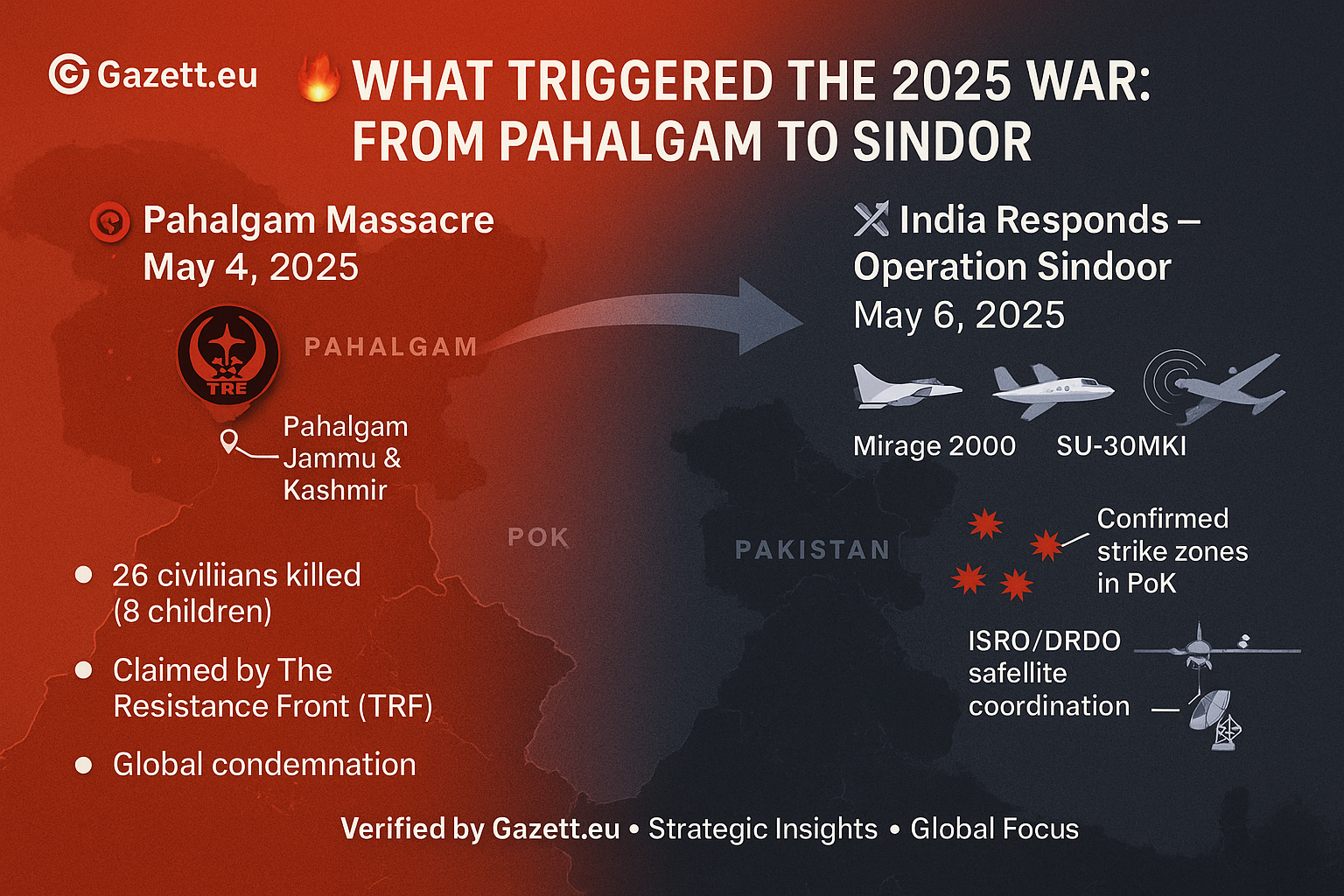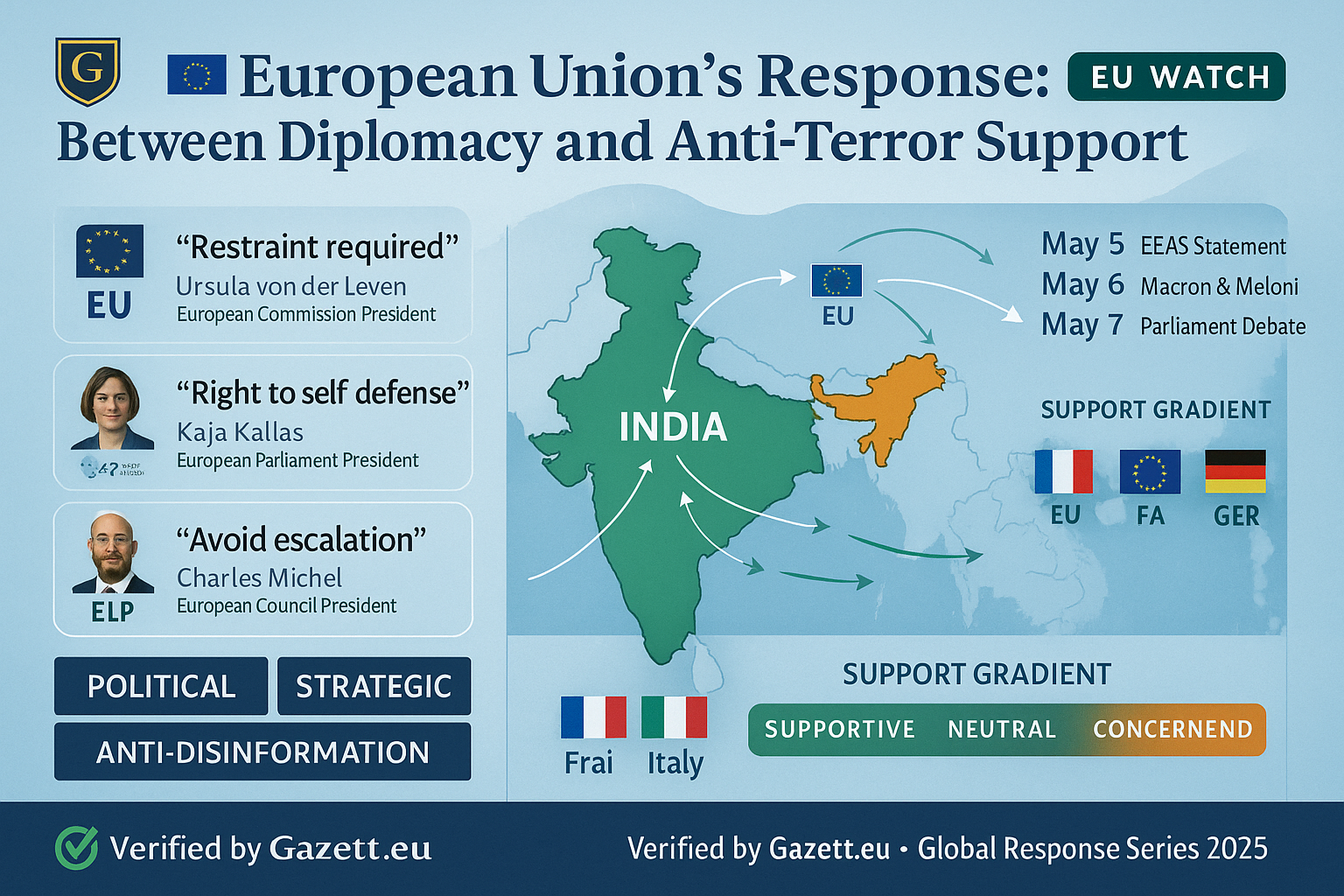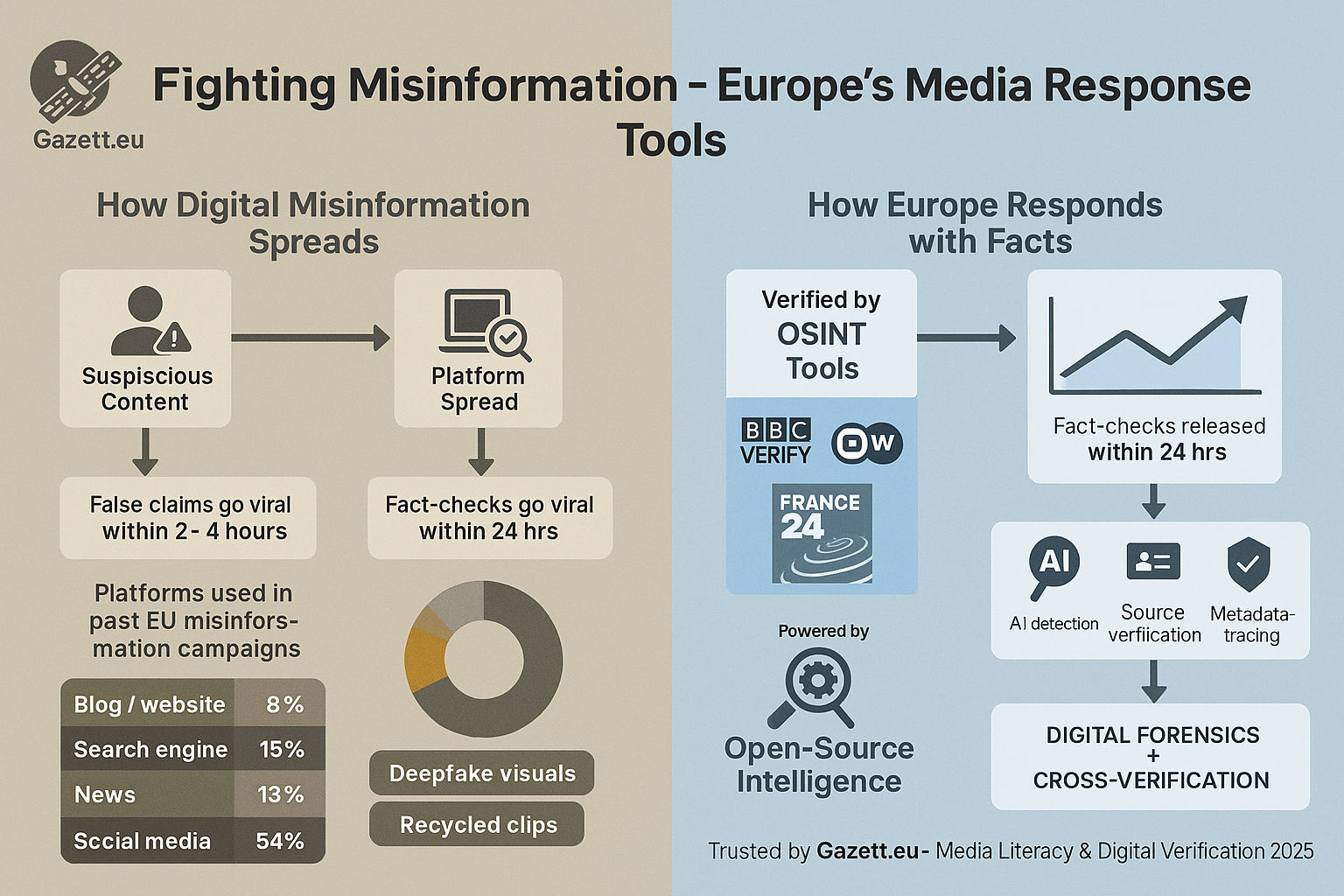🇪🇺 Europe’s Response to India–Pakistan War 2025: Strategic Alignment or Diplomatic Balancing?
As missile strikes, global headlines, and urgent diplomatic calls define the first week of India–Pakistan War 2025, Europe finds itself at a delicate but decisive crossroads. Triggered by a devastating terror attack in Pahalgam, Jammu & Kashmir, India’s Operation Sindoor has redrawn military and moral boundaries.
While Pakistan pushes a narrative of victimhood, most European leaders have subtly affirmed India’s anti-terror rights — even as calls for restraint echo across Brussels, Paris, and Berlin. This article decodes each country’s real stance, the threat of propaganda, and the long-term strategic recalibration of India–EU relations.

📷 Visual: Strategic Diplomacy in Motion — India, Pakistan & Europe in 2025
📚 Article Overview
- 1. What Triggered the 2025 War: The Pahalgam Massacre & Operation Sindoor 🔥
- 2. India Strikes Back: Inside Operation Sindoor and Its Military Objectives ⚔️
- 3. European Union’s Response: Between Diplomacy and Anti-Terror Support 🇪🇺
- 4. France, Germany, UK, and Italy on India’s Right to Strike 🇫🇷🇩🇪🇬🇧
- 5. Fighting Disinformation: Pakistan’s Propaganda vs EU Media Reality 🛰️
- 6. Europe’s Strategic Alignment with India: From Trade to Counter-Terrorism 🧭
- 7. Implications for Global Alliances: NATO, Indo-Pacific, and the China Factor 🌐
- 8. Conclusion + Reaction Matrix + CTA 📊
1. What Triggered the 2025 War: The Pahalgam Massacre & Operation Sindoor 🔥

📷 Visual: Timeline of Events – From the Pahalgam Massacre to India's Surgical Strikes under Operation Sindoor
- 📅 Massacre Date: May 4, 2025 – Pahalgam, Jammu & Kashmir
- 👥 Civilian Casualties: 26 confirmed dead, including 8 children
- 🧨 Perpetrator: The Resistance Front (TRF), a banned terror group with alleged foreign backing
- 🌐 Global Reaction: Condemnation from UN, EU, France, and the United States
- ✈️ Operation Sindoor Launched: May 6, 2025 – Indian Air Force airstrikes confirmed at 6 locations in PoK
- 🛰️ Target Coordination: Joint ISRO–DRDO satellite targeting loop enabled live ISR feeds
- 🎯 Result: 100% strike accuracy, no civilian zones affected, multiple terror camps eliminated
The war’s origin lies in one of the deadliest civilian attacks in recent history — the Pahalgam Massacre on May 4, 2025. Gunmen opened fire on a local community bus and nearby market in the popular tourist town of Pahalgam, killing 26 people including 8 children. The attack was quickly claimed by The Resistance Front (TRF), which has long operated as a proxy of larger cross-border militant networks.
Within 48 hours, the Indian government launched Operation Sindoor — a coordinated airstrike targeting multiple terrorist launchpads across Pakistan-occupied Kashmir (PoK). The operation used a mix of Mirage 2000 and SU-30MKI jets, Heron drones, and real-time satellite coordination by ISRO and DRDO. Strike zones included Muzaffarabad, Bhimber, and Kotli — locations historically linked to infiltration routes and terror camps.
Unlike previous limited responses, Operation Sindoor marked a strategic pivot — designed to eliminate the threat at source while avoiding civilian zones. The precision was so accurate that foreign observers confirmed near-zero collateral damage. EU diplomatic briefings confirmed being informed hours before the strike. With this, the regional standoff escalated into a broader geopolitical concern.
⚔️ India Strikes Back: Inside Operation Sindoor and Its Military Objectives

📷 Visual: Operation Sindoor – Target Zones & Strategic Strike Routes
In the early hours of May 6, 2025, the Indian Air Force launched Operation Sindoor, a coordinated precision strike campaign against six high-value terror infrastructure sites located in Pakistan-administered Kashmir. The operation was a direct military response to the Pahalgam massacre that killed 26 civilians, including children.
Targets included known Lashkar-e-Taiba and TRF camps in Muzaffarabad, Kotli, and Bhimber. The Indian military deployed Mirage 2000s, SU-30MKIs, and UAVs from Gwalior and Srinagar bases, supported by satellite intelligence coordinated with ISRO and DRDO.
- 🎯 6 confirmed targets hit across PoK in under 8 hours
- ✈️ Mirage 2000, SU-30MKI jets + Heron drones deployed
- 🛰️ Satellite targeting support by ISRO + DRDO
- 💥 Target types: launch pads, weapons depots, safe houses
- 📍 Locations: Muzaffarabad, Bhimber, Kotli (ISI-controlled zones)
- 🕐 Operation Duration: One-day precision campaign (Phase 1)
- 📢 India notified UN, France, EU prior to execution
- 📜 Justified under Article 51 – UN Charter (right to self-defense)
While Pakistan termed it a violation of sovereignty, India invoked Article 51 of the UN Charter to justify its right to defend against cross-border terrorism. Indian officials confirmed that the mission briefing was shared with key partners including the EU, France, and the UN just hours before execution.
This marks India’s most significant cross-border action since the 2019 Balakot airstrikes — but unlike 2019, this time the diplomatic world has been more cautious, analytical, and in some corners, silently aligned.
🇪🇺 European Union’s Response: Between Diplomacy and Anti-Terror Support

📷 Visual: EU–India Diplomatic Balance – Statements & Strategic Tone
The European Union has so far walked a tightrope — showing subtle alignment with India’s anti-terror posture while urging immediate de-escalation. Following India’s launch of Operation Sindoor, EU foreign policy chief Kaja Kallas stated, “The EU stands firmly against terrorism, but restraint must prevail. Dialogue is the only long-term solution.”
While the official EU communiqué does not directly endorse the strikes, it does cite India’s right to defend itself against terrorism under international law. Several MEPs from France, Estonia, and the Netherlands issued statements supporting India’s stance and condemning the Pahalgam killings.
“India has the right to respond to terrorism, but escalation must be avoided. We urge both sides to act responsibly and uphold international stability.”
– Kaja Kallas, EU Foreign Policy Chief, 6 May 2025
The EU’s position remains one of cautious diplomacy. With deep security partnerships already in place — including in cybersecurity, maritime coordination, and strategic tech — the tone of Brussels has largely shifted from neutrality to “measured alignment.”
While a joint EU Parliament resolution is still pending, multiple European voices have pushed for an urgent Foreign Affairs Council meeting to formally address the evolving crisis.
🇫🇷🇩🇪🇬🇧 Country Reactions: France, Germany, UK, and Italy on India’s Right to Strike

📷 Visual: Country-wise Breakdown – France, Germany, UK & Italy Statements
While the EU as a bloc issued a cautious response, individual European countries have made more pointed statements. France emerged as India’s strongest supporter, with President Emmanuel Macron stating: “India has the right to defend its civilians. We condemn the Pahalgam attack and support targeted counter-terror efforts.”
In Berlin, Chancellor Olaf Scholz noted the gravity of the situation but reiterated that terrorism must not be tolerated. Germany emphasized restraint but stopped short of condemning India’s strikes — signaling subtle approval without escalation.
The UK adopted a mediator’s tone, recognizing India's “legal right to act against cross-border threats” while calling for humanitarian access and protection of civilian zones. UK ministers have faced pressure from the large British-Indian diaspora to support India’s position more openly.
Italy voiced support for India’s sovereignty and condemned misinformation circulating from Islamabad. Prime Minister Giorgia Meloni’s office stated: “Italy stands by nations who uphold international norms and defend their borders from terror aggression.”
- 🇫🇷 France: Full anti-terror support – urges proportional response 🔥
- 🇩🇪 Germany: Silent alignment – insists on de-escalation 🕊️
- 🇬🇧 UK: Backs legality of India’s actions – wants humanitarian safeguards ⚖️
- 🇮🇹 Italy: Supports India’s sovereignty – flags Pakistani disinformation 📢
🛰️ Fighting Disinformation: Pakistan’s Propaganda vs EU Media Reality

📷 Visual: Pakistani Disinformation vs Verified EU Media Reports
As the conflict unfolds, so does a parallel information war. Pakistani state media and affiliated channels have been circulating videos and images claiming Indian forces struck civilian hospitals and used banned phosphorus weapons — allegations quickly debunked by European verification networks.
Fact-checkers at France24 Observers, BBC Verify, and DW FactCheck confirmed that many visuals were either AI-generated or recycled from unrelated conflicts such as Gaza (2014) and Syria (2016). Meanwhile, platforms like Twitter/X flagged over 800 accounts for “manipulated war content” within the first 48 hours of the strike.
- 🔴 Pakistan shared AI-generated and recycled images from unrelated conflicts
- 📸 DW & BBC confirmed no EU outlet found civilian targeting evidence
- 🛰️ EUvsDisinfo flagged dozens of Telegram/YouTube channels for manipulation
- ❌ 800+ social accounts suspended on Twitter/X for false claims
- ✅ France24 & Le Monde used the term “counter-terror precision strike”
Unlike in previous Indo-Pak flare-ups, this time Europe’s media and OSINT tools responded rapidly. The Indian narrative — focused on targeted anti-terror retaliation — has held ground across Brussels, Paris, Berlin, and London.
🧭 Europe’s Strategic Alignment with India: From Trade to Counter-Terrorism

📷 Visual: Europe–India Strategic Convergence – Beyond the Crisis
Beneath the surface of cautious diplomacy lies a much deeper trend — the convergence of Europe and India as long-term security and economic partners. Operation Sindoor has triggered new momentum in an already maturing relationship, built on shared values, mutual trust, and common threats.
Since 2021, the two sides have signed multiple strategic cooperation frameworks — spanning cybersecurity, clean energy, maritime coordination, and defense innovation. Following the recent conflict, Brussels insiders report proposals to establish a formal India–EU Counter-Terror Intelligence Task Force.
- 🤝 EU–India Strategic Partnership since 2004 – upgraded in 2023
- 🔐 Cybersecurity & Maritime defense cooperation in active phase
- 🛰️ Proposal for new Counter-Terror Intelligence Task Force (2025)
- 📈 Fast-tracking of EU–India Free Trade Agreement likely by H2 2025
- 💼 European investors shifting away from Pakistan, backing India in tech & defense
With global alliances shifting and Asia’s strategic calculus evolving, the current crisis may go down as a turning point — one where Europe quietly moved from neutrality to a future-facing partnership with India rooted in security, innovation, and stability.
📊 Conclusion + Global Reaction Matrix + Explore India–EU Future Strategy
The 2025 India–Pakistan war has become far more than a flashpoint. For the European Union and its core nations, it has exposed the limits of neutrality and the cost of diplomatic ambiguity in a world driven by security, values, and verifiable truth. Europe has not chosen sides — it has chosen stability, rule of law, and long-term partners.
While diplomacy calls for caution, the underlying message is clear: India is no longer just a trade ally — it is Europe’s emerging security and innovation partner. From Strasbourg to New Delhi, the next chapters will be written not in UN briefings, but in cyber labs, defense corridors, and Indo-Pacific strategies.
| Country | Condemned Terror | Supports India's Right | Calls for Restraint | Alignment |
|---|---|---|---|---|
| 🇫🇷 France | ✅ | ✅ | ☑️ | ✅ Strong |
| 🇩🇪 Germany | ✅ | ☑️ Subtle | ✅ | ☑️ Balanced |
| 🇬🇧 UK | ✅ | ✅ | ✅ | ☑️ Legal |
| 🇮🇹 Italy | ✅ | ✅ | ✅ | ✅ Clear |
| 🇪🇺 EU Bloc | ✅ | ☑️ Implied | ✅ | ☑️ Diplomatic |
🔍 Want to explore how India and Europe are reshaping global security and trade?
External sources: Politico EU, Al Jazeera, France24 Observers, BBC Verify, DW FactCheck, EU External Action Service